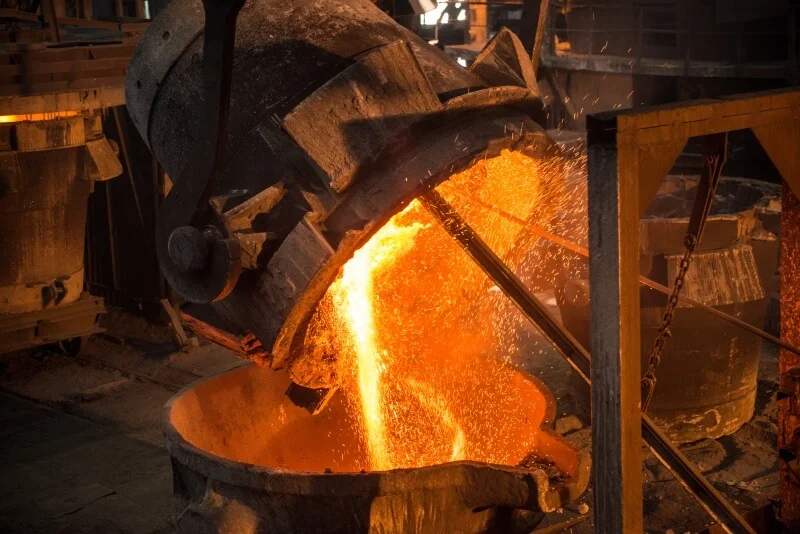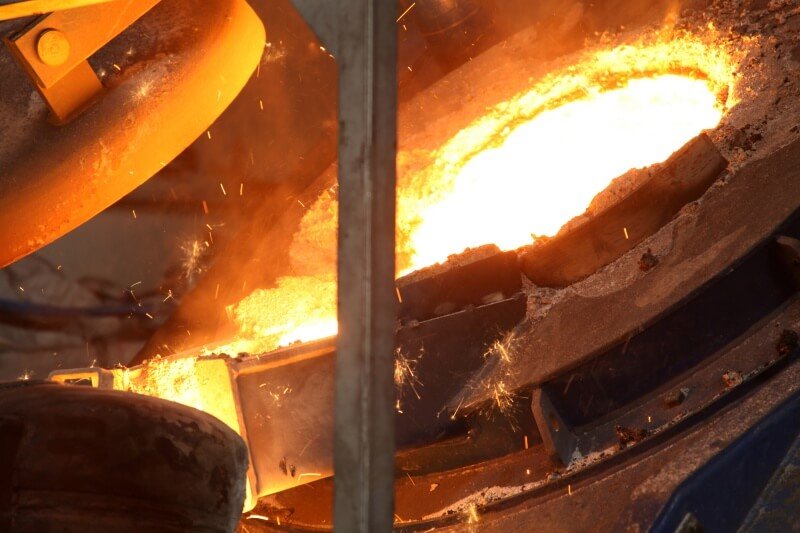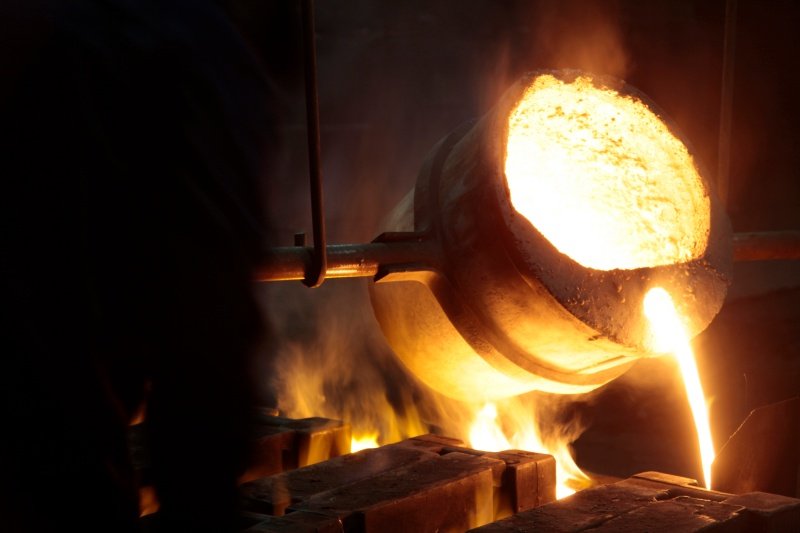Struggling with defective aluminum castings that miss dimensional targets? Those failures cause weak parts, delays, and budget hits. This guide demystifies the aluminum casting shrinkage percentage, so you can predict shrinkage, set correct allowances, and deliver flawless, in-tolerance parts every time.

What’s the core aluminum casting shrinkage percentage?
Aluminum casting naturally shrinks as the metal cools from a liquid to a solid. Understanding this process is the first step to controlling it for a successful final product. This shrinkage occurs in three distinct phases which we will explore.
Why Does Molten Aluminum Shrink?
As aluminum cools, its atoms arrange into a denser, crystalline structure, causing a volume reduction. Here’s the deal: this is a fundamental property of the metal that must be managed.
- It’s a natural physical process.
- Volume decreases as it solidifies.
- Proper planning is essential for control.
What are the three phases of shrinkage?
The process unfolds in three stages: liquid shrinkage, solidification shrinkage, and solid shrinkage. But wait, there’s more: each phase requires a different management strategy.
- Liquid: Cooling while still molten.
- Solidification: Phase change from liquid to solid.
- Solid: Cooling from solid to room temperature.
How it impacts your final product.
Uncontrolled shrinkage can lead to dimensional inaccuracies and internal defects like porosity. The bottom line is: it directly affects the part’s strength and usability.
- Causes dimensional variations.
- Can create internal voids.
- Weakens the final casting.
Key Takeaway: Understanding the three phases of shrinkage—liquid, solidification, and solid—is foundational to preventing casting defects and ensuring part quality.
| Phase | Description | Key Challenge |
|---|---|---|
| Liquid | Volume reduction while molten. | Maintaining mold fill. |
| Solidification | Phase change from liquid to solid. | Preventing voids. |
| Solid | Cooling down to room temperature. | Maintaining dimensions. |
This table shows that each shrinkage phase presents a unique challenge that requires a specific engineering solution.
The liquid aluminum casting shrinkage percentage
This initial phase happens as the molten metal begins to cool but is still fully liquid. While it’s the first step, it is generally the least problematic of the three stages. Proper foundry techniques easily manage this volume reduction.
The First Stage: Liquid Cooling
This is the reduction in volume as molten aluminum cools before solidification begins. Here’s the deal: the metal is still fluid enough to fill the mold completely.
- Occurs above the solidification temperature.
- Volume reduction is relatively small.
- Metal flow is not yet restricted.
Is this phase a major concern?
Typically, this phase is not a major concern for casting quality. Why is that? Because feeders and risers can easily supply more molten metal to compensate.
- Easily compensated with reservoirs.
- Does not usually cause defects.
- It is a predictable part of the process.
How foundries manage this stage.
Foundries use a riser system, which acts as a reservoir of molten aluminum. The bottom line is: these risers feed the casting as it shrinks, ensuring the mold remains full.
- Risers provide extra molten metal.
- Prevents voids from forming early.
- Ensures a complete fill.
Key Takeaway: Liquid shrinkage is effectively managed by using a well-designed riser system that continually feeds the mold as the molten aluminum begins to cool.
| Technique | Purpose | Effectiveness |
|---|---|---|
| Riser System | Acts as a reservoir for molten metal. | High |
| Gating Design | Controls the flow into the mold cavity. | Moderate |
| Pouring Temp | Optimized to manage the cooling rate. | Moderate |
Properly designed risers are the most direct and effective method for counteracting liquid shrinkage.
The solidifying aluminum casting shrinkage percentage
This is the most critical phase where the majority of shrinkage occurs. As the metal transitions from liquid to solid, its volume decreases significantly. This stage is where defects are most likely to form if not managed correctly.
The Critical Liquid-to-Solid Phase
This is where the metal undergoes its phase change, creating the greatest potential for defects. Here’s the deal: this is where an expert foundry proves its worth.
- Most significant volume reduction occurs here.
- High risk of porosity and cavities.
- Requires precise process control.
How do risers prevent defects here?
Risers continue to feed molten metal into the casting as it solidifies from the outside in. But wait, there’s more: this targeted feeding prevents voids from forming in the part’s core.
- They compensate for the large volume loss.
- Direct liquid metal to last-to-freeze areas.
- Ensures a solid, dense casting.
The primary source of shrinkage.
The phase change from liquid to solid is responsible for the most significant shrinkage. The bottom line is: effectively managing this stage is key to a strong, defect-free part.
- This stage defines internal integrity.
- Improper control leads to failure.
- It is the main focus of shrinkage management.
Key Takeaway: Solidification shrinkage is the most critical stage; a properly engineered riser and gating system is essential to feed the casting and prevent defects.
| Factor | Role in Solidification Shrinkage | Control Method |
|---|---|---|
| Riser | Feeds molten metal to the casting. | Sizing and placement. |
| Gating | Directs metal flow and cooling. | Engineering design. |
| Alloy Type | Determines the shrinkage range. | Material selection. |
These factors must be managed in concert to control solidification shrinkage successfully.
The solid state aluminum casting shrinkage percentage
After the aluminum has fully solidified, it continues to shrink as it cools to room temperature. At this point, the gating and riser systems are also solid. Therefore, they can no longer feed the casting to compensate for this final stage.
Cooling to Ambient Temperature
This final phase occurs after the casting is completely solid. Here’s the deal: though less dramatic, this shrinkage still affects the final dimensions.
- The part is fully solid.
- Shrinkage is due to thermal contraction.
- It impacts the final tolerance.
Can feeders help at this final stage?
No, feeders and risers are also solid and can no longer supply molten metal. Why is that? The entire system cools together, so compensation must be built-in beforehand.
- The feeding network is frozen.
- No more liquid metal is available.
- Shrinkage must be pre-calculated.
Compensating with pattern design.
Foundries build the pattern slightly larger than the final desired dimensions. The bottom line is: this “shrinkage allowance” ensures the part cools down to the correct size.
- The pattern is oversized by a set percentage.
- Accounts for predictable solid shrinkage.
- Ensures dimensional accuracy.
Key Takeaway: Solid shrinkage is managed proactively by designing the initial pattern with a “shrinkage allowance,” making it larger than the final part.
| Strategy | Description | Application |
|---|---|---|
| Pattern Allowance | Making the pattern oversized. | Solid Shrinkage |
| Riser System | Feeding molten metal. | Liquid & Solidification |
| Cooling Control | Managing the cooling rate. | All Phases |
Pattern allowance is the specific and necessary solution for managing the final solid-state shrinkage.
The alloy & aluminum casting shrinkage percentage
Different aluminum alloys have unique chemical compositions that influence how much they shrink. Your choice of alloy directly impacts the final dimensions of your casting. This must be discussed with your foundry partner from the start.
Do all aluminum alloys shrink the same?
No, different aluminum alloys have different shrinkage rates. Here’s the deal: elements like silicon can reduce shrinkage, so alloy selection is critical.
- Composition affects shrinkage.
- Pure aluminum shrinks more than alloys.
- Rates are well-documented for each alloy.
Choosing the right alloy for your needs.
Work with your foundry to select an alloy that meets your project’s dimensional and structural needs. The bottom line is: this ensures we can meet your expectations for the final part.
- Consider strength and finish.
- Balance cost and performance.
- Align alloy choice with tolerances.
Key Takeaway: The specific aluminum alloy you choose has a direct and predictable impact on the shrinkage rate, making material selection a critical design decision.
| Alloy Property | Impact on Shrinkage | Example |
|---|---|---|
| Silicon Content | Higher silicon reduces shrinkage. | A356 vs. pure aluminum |
| Freezing Range | Wider ranges can increase risk. | Varies by alloy series. |
| Fluidity | Affects mold filling and feeding. | A380 is highly fluid. |
Selecting an alloy with favorable properties is a key strategy for minimizing shrinkage-related issues.
Defects & aluminum casting shrinkage percentage
If the aluminum casting shrinkage percentage is not properly controlled, it can lead to severe internal defects. These flaws compromise the structural integrity of the part. This can result in catastrophic failure during use.
What are shrinkage cavities and porosity?
These are internal voids created when there is not enough molten metal to fill the space left by shrinkage. Here’s the deal: they are like hidden cracks within your part.
- Cavities: Larger, concentrated voids.
- Porosity: Smaller, scattered voids.
- Both weaken the casting.
How defects compromise part strength.
Shrinkage defects act as stress concentrators, significantly reducing the part’s load-bearing capacity. But wait, there’s more: this makes the component unreliable and unsafe for use.
- Reduces structural integrity.
- Creates points of failure.
- Lowers fatigue resistance.
The risk of component failure.
Parts with internal shrinkage defects can fail unexpectedly under normal operating conditions. The bottom line is: choosing a foundry with expert shrinkage control is vital for reliability.
- Failure can be catastrophic.
- Risks damaging equipment or causing injury.
- Ensures a strong, reliable product.
Key Takeaway: Uncontrolled shrinkage creates internal cavities and porosity that severely weaken the casting, posing a significant risk of failure in the final application.
| Defect Type | Description | Primary Cause |
|---|---|---|
| Shrinkage Cavity | A large internal void. | Insufficient feeding. |
| Shrinkage Porosity | Small, dispersed voids. | Inadequate feeding/gas. |
| Surface Sink | A depression on the casting surface. | Localized shrinkage. |
These defects all stem from the same root cause: a failure to adequately compensate for metal shrinkage during cooling.
Pattern tips for aluminum casting shrinkage percentage
To achieve the correct final dimensions, the initial pattern used to create the mold must be designed larger. This intentional oversizing is known as a shrinkage allowance. It is a critical factor for ensuring dimensional accuracy.
Why are patterns made larger?
Patterns are made larger to compensate for the total volume the aluminum will lose as it cools from liquid to solid. Here’s the deal: it’s a proactive measure to ensure accuracy.
- It accounts for all three shrinkage phases.
- The part shrinks down to the correct size.
- Ensures the final part meets specifications.
What is a shrinkage allowance?
A shrinkage allowance is the percentage by which a pattern is made larger than the final part. But wait, there’s more: this percentage varies based on the specific alloy used.
- A precise, calculated oversizing.
- Different for every aluminum alloy.
- Crucial for achieving tight tolerances.
Ensuring dimensional accuracy.
Despite the best planning, minor deviations can occur, especially in complex shapes. The bottom line is: a well-designed pattern is your best defense against dimensional errors.
- It’s the foundation of an accurate part.
- Reduces post-casting adjustments.
- Critical for complex geometries.
Key Takeaway: A correctly applied shrinkage allowance in the pattern design is the most important step to ensuring the final casting meets its required dimensional specifications.
| Design Element | Purpose | Benefit |
|---|---|---|
| Shrinkage Allowance | Compensates for metal contraction. | Dimensional Accuracy |
| Draft Angle | Eases pattern removal from sand. | Prevents Mold Damage |
| Machining Allowance | Adds extra material for finishing. | Achieves Final Tolerances |
Each of these pattern design elements works together to produce a high-quality, dimensionally accurate casting.
Mitigating aluminum casting shrinkage percentage
Successfully mitigating shrinkage requires a holistic approach that includes more than just pattern design. A properly engineered riser and gating system is crucial. This is where the expertise of an experienced foundry becomes invaluable.
What is a riser system?
A riser is a reservoir of molten metal attached to the mold cavity. Here’s the deal: it feeds the casting as it shrinks, preventing voids.
- Acts as a supply of liquid metal.
- Placed at the thickest sections.
- The last part of the casting to solidify.
The importance of gating design.
The gating system directs the flow of molten aluminum into the mold. But wait, there’s more: it controls filling speed and cooling patterns to promote directional solidification.
- Ensures smooth, non-turbulent flow.
- Helps control the cooling sequence.
- Prevents premature freezing.
How an expert foundry helps.
An experienced foundry uses simulation software and decades of expertise to design these systems. The bottom line is: we ensure your casting is strong, dense, and defect-free.
- We model the entire casting process.
- We optimize riser and gate placement.
- Guarantees a reliable final product.
Key Takeaway: Effective mitigation of shrinkage relies on an expertly designed riser and gating system, which controls cooling and feeds the casting to prevent defects.
| System | Function | Goal |
|---|---|---|
| Riser System | Provides a reservoir of molten metal. | Prevent Shrinkage Voids |
| Gating System | Controls metal flow and filling. | Promote Directional Solidification |
| Chills/Insulators | Manipulate local cooling rates. | Ensure Soundness |
An integrated system design is the only way to reliably mitigate all forms of shrinkage.
Machining & aluminum casting shrinkage percentage
Even with perfect shrinkage control, some critical surfaces may require machining to meet tight tolerances. Foundries account for this by adding extra material to the casting. This ensures a flawless finish after the final machining steps.
What are machining allowances?
This is extra material strategically added to the casting design. Here’s the deal: this material is later removed during CNC machining to achieve the final, precise dimensions.
- An extra “skin” of material.
- Added only where machining is needed.
- Ensures a clean surface and tight tolerance.
Achieving precise final dimensions.
Machining removes any minor surface imperfections and brings the part to its exact specified dimensions. But wait, there’s more: we machine 95% of the castings we pour.
- Guarantees print-perfect accuracy.
- Creates critical mating surfaces.
- Provides superior surface finishes.
Our advanced CNC machining capabilities.
We use state-of-the-art CNC centers to process castings of nearly any size with high accuracy. The bottom line is: we deliver parts that are precisely to print and on time, every time.
- Equipped with 5-axis capabilities.
- Large horizontal and vertical centers.
- Decades of experience in machining aluminum.
Key Takeaway: Machining allowances are intentionally added material that enables post-casting CNC work, guaranteeing that the final part meets the most stringent dimensional and surface finish requirements.
| Service | Description | Customer Benefit |
|---|---|---|
| Casting | Creating the near-net shape part. | Material & Cost Efficiency |
| Machining | Final dimensioning and finishing. | Precision & Tolerance |
| One Source | Integrated casting and machining. | Quality Control & Reliability |
Our integrated ‘One Source, One Responsibility’ approach guarantees quality from raw material to finished part.
Conclusion
We’ve explored how understanding the three shrinkage phases is key to managing the aluminum casting shrinkage percentage. By controlling this process with proper alloy selection, pattern design, and riser systems, you prevent defects like porosity and ensure dimensional accuracy. One Responsibility’ promise means we handle everything from engineering to precision machining, delivering parts that are precisely to print and on time, every time.
Stop letting defects ruin your project. Master your aluminum casting shrinkage percentage with a team you can trust. Let our in-house engineers review your project for cost savings—contact us to request a quote today!
Your aluminum casting shrinkage percentage FAQs
Can I use any aluminum alloy for my casting?
No, it is not recommended. Different alloys have different shrinkage rates, and your choice must align with your project’s dimensional and strength requirements.
What’s the best way to prevent shrinkage defects?
The best way is a combination of expert engineering, including a properly designed riser system, precise pattern allowances, and correct alloy selection.
How do I know if my pattern is sized correctly?
Your foundry partner is responsible for this. They calculate the correct “shrinkage allowance” based on the chosen alloy to ensure the pattern is oversized correctly.
Can you machine my part for me after casting?
Yes, absolutely. We machine 95% of the castings we pour in-house, ensuring precise final dimensions and a single source of responsibility for quality.
How do I know if a foundry can handle shrinkage?
Ask about their experience and their process. A capable foundry will discuss their use of riser systems, pattern allowances, and simulation software to control shrinkage.




